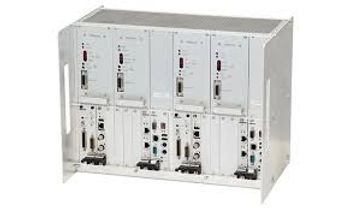
BOOSTING GAS TURBINE EFFICIENCY
PERFORMANCE CAN BE IMPROVED BY OPTIMIZING THE EFFECTIVENESS OF COOLING HOLES
Jens Dickhoff, Masahide Kazari & Ryozo Tanaka
The key to boosting efficiency of gas turbines (GTs) is by finding ways to increase temperatures at the combustor exit and high-pressure turbine stage inlet. But higher operating temperatures risk the integrity of high-pressure turbine components, especially vanes and blades since modern turbine stage inlet temperatures exceed the melting points of their materials. To combat this, turbine blade designs incorporate film cooling.
During film cooling, cool air is bled from the compressor stage, ducted to the internal chambers and discharged through small holes in the blade and vane walls. This air provides a cool insulating layer.
Metal temperatures are calculated using a dynamically coupled or conjugate heat transfer (CHT) solution embedded in the CFD tool. This solution concurrently calculates the fluid and metal temperatures of a solid body having a gas or liquid flow over and inside it (such as a GT blade or vane).
CHT was used in the design of the L30A from Kawasaki Heavy Industries (KHI), a 30 MW GT. It has a 41.2% simple cycle thermal efficiency, a world record in its class. L30A was developed by KHI with support from B&B-AGEMA.
Film cooling effectiveness is improved using fan-shaped holes to direct the flow of the air jets instead of conventional cylindrical holes. In addition, CFD simulation used a technique known as double jet film cooling, as well as nekomimi (Japanese for cat’s ears, reflecting the visual appearance of the holes) film cooling technology (Figure 1).
Figure 1: Film cooling hole geometries: cylindrical (top), fan-shaped (middle), nekomimi (bottom)
The computational domain used to test the cooling effectiveness of different shaped holes consists of a main cross-flow duct and a plenum for the coolant supply, connected by the film cooling hole. The walls at the lateral sides are defined as symmetry planes in order to represent a row of film cooling holes, typical for GT applications.
As illustrated in Figure 2, a similarly sized nekomimi hole results in about equal film cooling effectiveness at a lower mass flow rate compared to the fan-shaped hole. Note that on the normalized scale from 0-1 that is typically used for cooling effectiveness, red=1 (better) while violet=0 (worse). The result has been cooling improvements of 200% to 300% in the nekomimi designs over reference shaped holes.
Figure 2: Comparison of cooling effectiveness and mass flow rate for a nekomimi versus fan-shaped hole as shown in STAR-CCM+ (by CD-adapco)
Nekomimi-shaped holes
As air used in the film cooling is extracted from the turbine’s high-pressure compressor, the amount of air used for cooling decreases thermal efficiency. Furthermore, film cooling leads to mixing losses and reduced temperature within the hot gas passage. These inefficiencies can be ameliorated by finding ways to reduce the amount of cooling air needed, and to establish a more homogenous blade metal temperature distribution.
The cooling fluid injection through a hole leads to a jet in cross-flow situation. Secondary flow structures, including rotating vortices, are generated by interaction between the coolant jet and the cross-flow which can degrade film cooling effectiveness.
These degradations can be remedied by using a shaped-hole exit instead of a round hole, which leads to reduced momentum flux ratio between the coolant and cross flow at the cooling-hole exit (caused by the flow deceleration inside the diffusor part of the shaped hole). A Coandă effect (the tendency of a fluid jet to stay attached to a convex surface) facilitates flow hugging the wall behind the hole. To reduce the undesirable mixing between the coolant and the hot gas, double jet film cooling (DJFC) technology was introduced.
The nekomimi technology takes this a stage further by combining the two cylindrical holes of DJFC within a single hole design to overcome air supply inefficiency. This was achieved by shifting the holes of the DJFC configuration to the same streamwise position (Figure 3, Step 1), uniting both holes (Figure 3, Step 2) and replacing the two supply holes with a central one (Figure 3, Step 3).
Figure 3: Nekomimi design concept: a) Step 1 (DJFC) b) Step 2 c) Step 3 (nekomimi)
Design exploration
Recently HEEDS design exploration software from Siemens PLM subsidiary Red Cedar Technology plus the HEEDS-based Optimate+ add-on module for STAR-CCM+ were implemented to automate the evaluation of hundreds of designs in the time previously required to assess just a handful.
This simplified the process of comparing large numbers of traditional fan-shaped hole designs to nekomimi-shaped holes.
As shown in Figure 4, the nekomimi technology has better spatially averaged film cooling effectiveness for coolant mass flow rates between 8 g/s and 17 g/s. Below and above that range, both cooling hole concepts can reach comparable values for cooling effectiveness.
Figure 4: Film cooling effectiveness for all tested nekomimi and fan-shaped film cooling hole designs
Moreover, this kind of GT performance insight enables engineers to discover better designs faster and to make informed decisions regarding trade-offs they must make when selecting their final design (such as selecting a high-enough film cooling effectiveness and, at the same time, a low-enough coolant mass flow rate).
Jens Dickhoff, Project Manager at B&B-AGEMA, a German engineering services firm specializing in the design of energy conversion machinery and plants. http://www.bub-agema.de
Masahide Kazari, Senior Manager, Thermal System Research Department at Kawasaki Heavy Industries
Ryozo Tanaka, Manager, Gas Turbine Development Department at Kawasaki Heavy Industries https://global.kawasaki.com
Newsletter
Power your knowledge with the latest in turbine technology, engineering advances, and energy solutions—subscribe to Turbomachinery International today.




